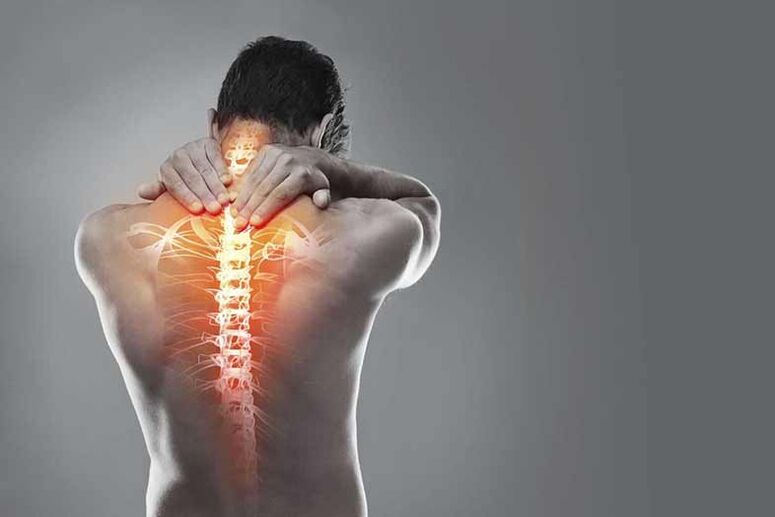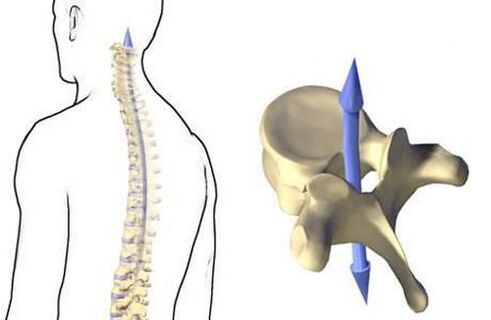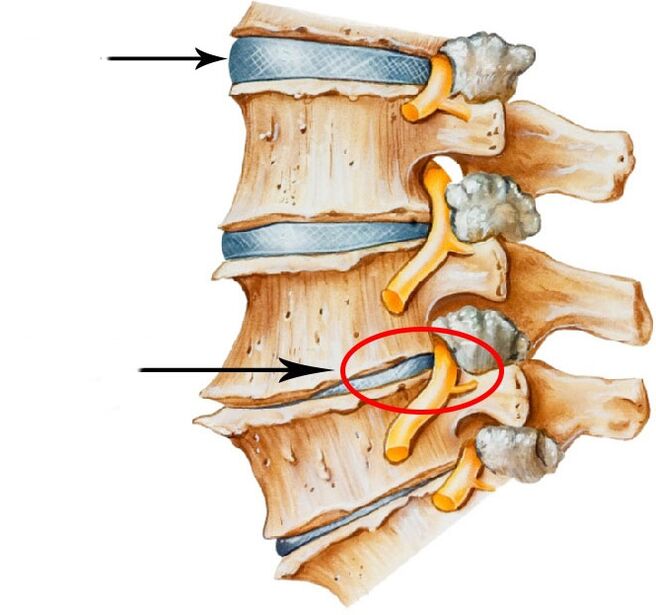
According to statistics, almost half of the people from 30 to 55 suffers from osteochondrose.The lower age of the disease in recent years has decreased to 18 years.
What is osteochandrosis
Osteochondrosis of spineIt is expressed in the defeat of an intervertebral disk, which loses elasticity, elasticity, cracks.
Cervical osteochondrosisassociated with disk damage in the neck spine.
How's the spine doing
If it is a little simplified essence for a better understanding, then the spine can be described as follows.
The spine consists of a separate, similar to each other in the form of vertebrae that are located above the other.
Despite some differences in the form, there is common in the structure of all vertebrae.In each verder there is a hole - all holes are also one above the other and shape the vertical channel (tunnel) that pass through the entire spine.
Within this thermal channel, the spinal cord passes.It passes vertically through holes in each ravine, and its roots (branches, in which the sensitive nerve for the completion) abandon the canal between each pair of vertebral.This is possible because the vertebrae is not lost each other and are not firmly attached, and between each pair of vertebral is a cartilage - intervertebral disk.

The wheels together with the ligaments connect the vertebra with each other, and also play the role of shock absorbers.Due to its elastic structure, they are elastic compressed during the movement and tilt of the body (on the side of the tilt) or undiscovered (when correcting).Thus, discs provide a vertical flexible and soften the load from vertical pressure from top to bottom to each spine spine, as well as vertical vibrations of up when they occur when they walk or run.After all, a person is a unique upright and direct creature.
Such spine is ensured if the entire load is properly distributed.Nature has created a spine amazingly stable, stubborn and at the same time flexible.
And if not?
If the shape of the spine, conceived by nature, for some reason (stop, overbeat the lower back, scolios, loss, loss, the ability to perform the function of absorption shock, flattened, cracks and deformed and deformed.They are kept on the sides, forming hernia.
Carrying interverters - There is also a person who is calculated for upright.Finally, only in humans, the spine has a vertical load.Such vertical squeeze throughout the life of all components of the spine (especially in people with excess) leads to gradual deterioration in blood supply to intervebrelne discs (vascular direction is grip) - disk loses endurance and strength.
What next?

Press on a disc herniaBlood vessels,Nerve rootsAnd sometimesspinal cord.
Consequences of cervical osteochondrosis
Due to changes in the anatomical ratios in the spine, blood vessels (main arteries and veins) are clenched.
What's going on:Due to changes in the anatomical ratios in the spine, blood vessels (main arteries and veins) are clenched.What leads to:
- Brain blood passes and brain violation of the brain.
- To violate the venous drain and accumulation of toxic substances in the brain tissues.
How is it manifested:
- Dizziness (up to short-term loss of consciousness).
- Headaches.
- Vid damage.Breach of smell, taste.
- Bulbar disorders related to the difficulties of swallowing, excuses, violations of general and speech breathing.
- Cognitive disorders: impaired memory, perception, complexity with attention concentration, the complexity of logical thinking.Breach of reading.
- Absent - mindularity.Inappropriateness.Decrease in confusion.Forgetfulness.
- Difficulties with pronouncements complex and long words, complex grammatical structures.
- Reduced performance, surge.
- Violations in emotional and personal sphere: sharp and unreasonable swing, emotional incontinence, irritability, rage.
Diagnostics: Cognitive disorders, aphasia, Disarthria Bulbar, can be diagnosed with diskulatory encephalopathy insufficiency, Vertebro-Baslar (VBN), etc. Drug therapy taken in these cases:
- Vascular medications.They have an extremely low database of evidence.They require the use of doctors and controlled by doctors, can cause a large number of different complications and side effects.
- Nootropne drugs.Require use strictly for appointment and controlled by doctors.Many have quite serious contraindications from the cardiovascular system (with hidden cardiac pathology can cause serious negative consequences).Most nootropes have no positive pharmacological result, that is, it is useless.
- Medications with sedative effect, including calming, antidepressants, barbitate, bromide.Psychotropic drugs.Require use strictly for appointment and controlled by doctors.They can be dependent and have more side effects (dizziness, headaches, visual damage, dry mouth, nausea, etc. Displays for embarrassment, falling libidas, body weight disorders).
There is a squeezing (compression) of nervous roots - nerves coming from the spinal cord to the body and tissue of the upper body.
What's going on:
There is a squeezing (compression) of nervous roots - nerves coming from the spinal cord to the body and tissue of the upper body.
What leads to: To the pronounced pain syndrome, often chronic, repeating.
How is it manifested:
- The pain in the neck, the back of the head (with head or rest, and recording, records or chronic).
- Headache (tension headache associated with the tension of the back of the door surface and head-head - pain, poured over the whole head, often accompanied by noise and ring in ears, flying in front of the eyes).
- Pain in the upper chest.
- Pains that simulate heartache, in the lungs.
- The pain in the upper back in the shoulders, shoulders.
- Shoulder pain or in hand.
- The arminess of the fingers, hand, hand completely.
Drug therapy taken in these cases:
- Nonsteroidal anti-inflammatory drugs (anti-pain, antipyretic), who used strictly for appointment and doctor's control and have side negative reactions from the gastrointestinal tract (gastritis, ulcers), cardiovascular system, kidneys.
- Preparations that mitigate muscular hyperponicity, require use strictly for their purpose and controlled doctors and have side negative reactions in the form of strong dizziness, weakness to completely exhausting.
The use of drug therapy is the most common practice in the treatment of osteochondrose.However, this is a symptomatic treatment.Medications are used to stop inflammatory processes and pain (sometimes you need to resort to a blockade of the Novocaine), by reducing neurological and psycho -emotional symptoms.The most important thing is that the pharmacological therapy occurs under the strict supervision of the doctor.
However, If You Do Not Directly Stop The Process Of The Balance Of The Spine And All Related Structures Laid Down By Nature (Violation of The Symmetry Of The Body, Flat Feet, Muscle Cramps That Occur As a Compensatory Reaction to Equilibrium), TheDisease Will Not Go Anywhere and at Some Point It Do Not Help And Should Not Help And Should Resort To The Operation.
Osteopathic treatment is focused on eliminating the above causes of osteochondrose, which is today recognized as the most efficient.
Osteopathic treatment osteochendrosis
Rule no.1 "Earlier, that's better" in case of osteochondrose, it works especially!Finally, for style of osteochondrose - does not extinguish pain or other syndromes, but to return the normal spine (for the intervertebral disk) even before contacting normal blood supply) and before contacting normal supplyBlood (for return to the blood supply) even before addressing normal blood) and before contacting the normal blood supply (for return in blood supply) and become irreversible.
Osteopath determines the place where displacement or deformation occurred, isReasons why the dishes came to the vessels in the spine.Osteopathy believes that the body is like a system in which everything is interconnected and affects each other, literally withdraws each other.This means that osteopath restores the work of all structures, changes in the chain lead to a violation of the intervertebral disk power.The task of osteopaths is to restore the ratio of organ and tissue balance, eliminate strains and clamps that interfere with full diet.And if in the event of a neglected disease, changes in the spine structure implies the violation of the work of internal bodies, osteopathic treatment will be focused on removing increased dysfunction.
That is, osteopath works with the basic cause of the disease, not eliminating his syndrome, including pain.Although they will start their work with it, with pain relief.However, there won't stop.The best way to work osteopathy combined with physiotherapy (ensures a reduction in pain and inflammatory processes) and physiotherapy exercises - exercise therapy (strengthens the muscular corset, helps the body in a new unusual but proper position).
Conclusions
- The neck cannot be treated frivolously.Since the brain should ensure smooth nutrition.And it depends on how healthy "conductor" is the door.
- You can't wait.The more disease run, the more difficult to overturn (and sometimes impossible).Osteopath is able to determine the disease when he is still in Rudia and does not show in any way.You should never ignore the diagnostic examination.
- It is impossible to ignore the prevention of osteochondrose.It is always easier than treatment of disease.

























